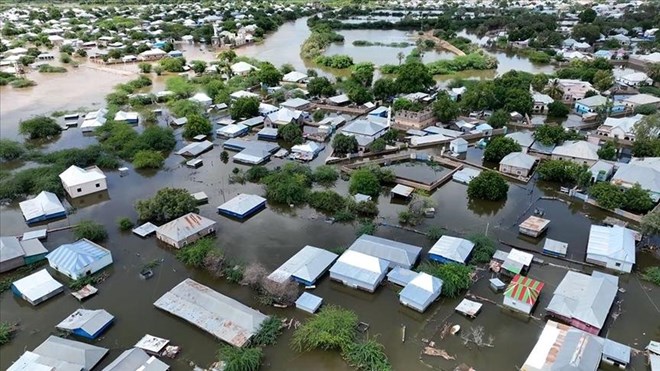
Mohammed Dhaysane
Friday November 17, 2023
Heavy rains expected in Bay region of South West, as well as parts of Somaliland and Galmudug, with riverine and flash flooding likely to continue until Nov. 21

Somalia is experiencing the worst climate-change-related floods in a century, wreaking havoc in many parts of the Horn of Africa country, affecting 1.24 million people and displacing over 456,800 more since the first week of October, said a statement issued by UN Office for the Coordination of Humanitarian Affairs (OCHA) on Thursday.
Heavy rains are also expected in the Bay region of the South West, as well as parts of Somaliland and Galmudug, with riverine and flash flooding likely to continue until Nov. 21, the OCHA Somalia said and warned that the risk of disease outbreaks, particularly cholera, is growing.
The Somali National Disaster Management Agency (SoDMA) in a separate statement on Thursday also issued another warning, stating that floods caused by the El Nino phenomenon will continue as water levels in the Jubba and Shabelle rivers continue to rise following torrential rains in parts of the country and the Ethiopian highlands.
According to the weather forecast, rainfall in Bay, Gedo, and Awdal could cause floods and landslides, the agency said.
Earlier on Wednesday, the agency announced an increase in the death toll, which now stands at 42 since Oct. 4.
Environmental changes in the country have had a significant impact on the natural environment, particularly the occurrence of flash floods caused by the El Nino phenomenon, said an official of the Mogadishu-based NGO Community Action for Climate Change (CACC).
“These floods have resulted in unprecedented situations for many lives. For example, cities such as Galkacyo, Baidoa, Baledweyne, Luuq, Bardera, and Burdhubo in the south and central regions of Somalia have been submerged,” CACC Executive Director Abdullahi Abdifatah Hassan told Anadolu.
He added that the severity of the situation is immense because the floods have submerged major infrastructure and rendered it inoperable.
He said the situation in parts of the country, including Galkacyo, the provincial capital of the Mudug region, Baidoa, the administrative capital of South West state, and Bardhere in the Gedo region, requires immediate attention and assistance from both local and national authorities, as well as humanitarian organizations.
“Climate change has far-reaching and devastating effects on various aspects of Somalia, including the destruction of critical infrastructure like Bardera Bridge that played a crucial role in facilitating transportation and commercial activities in Gedo region,” he said.
He said the bridge built in 1978 to connect the regions of Bay, Middle-Shabeelle, and Gedo, as well as neighboring countries like Kenya and Ethiopia, "tragically no longer exists today due to the destructive forces unleashed by climate change."
Somalia has declared the current humanitarian crisis caused by heavy rains and floods a "national humanitarian emergency," and the government has said it is committed to addressing the tragedy of floods that have devastated many parts of the country.
Southern Somalia is bracing for more flooding, Information Minister Daud Aweis also warned in a separate statement.
“In recent weeks, persistent showers have eroded road networks, rendered bridges unsafe, and submerged vital institutions like schools and farmlands,” he said in a statement on X on Thursday.